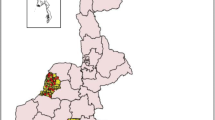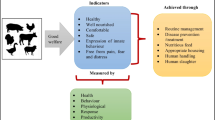Abstract
The aim of this study was to describe animal production on small farms in the Kaski district of Nepal, with the goal of identifying areas where animal health and productivity could be improved. Eighty-five randomly selected farms from four different Village Development Committees were visited. Farmers were interviewed and premises and animals visually inspected on all farms. Feed samples were collected from a subset of farms. The most commonly kept species were water buffalo (used for milk and meat), cattle (used for milk and labor), and goats (used for meat). Average milk production levels were 4.7 kg/day for water buffalo and 1.9 kg/day for cattle. All animals were milked manually, no calves were weaned, and only one farm practiced artificial insemination. A majority of cattle and goats had access to pasture, and a majority of farms fed their working or producing animals concentrates; however, nutritional input was insufficient in terms of energy, protein, and micronutrient content to increase levels of production. Goat-raising was the most profitable endeavor, followed by water buffalo and cattle. We conclude that animals have the potential to contribute significantly to improved livelihoods of farmers in terms of both income generation and non-tangible benefits. However, we found that significant constraints on animal production exist, including insufficient nutritional levels and a lack of preventative care resulting in animal disease. Furthermore, cultural considerations reflecting attitudes toward cattle shape farming in ways that may limit production. Nevertheless, targeted interventions that improve animal health and productivity are possible without being cost prohibitive.




Similar content being viewed by others
Abbreviations
- AAFCO:
-
Association of American Feed Control Officials
- AHTCS:
-
Animal Health Training and Consultancy Services
- BCS:
-
Body condition score
- VAHW:
-
Village Animal Health Worker
- VDC:
-
Village Development Committee
References
Anthony, V. M. and Ferroni, M., 2011. Agricultural biotechnology and smallholder farmers in developing countries, Current Opinion in Biotechnology. doi: http://dx.doi.org/10.1016/j.copbio.2011.11.020
Banerjee, G. 1998. A Textbook of Animal Husbandry, (Oxford and IBH Publishing Co. Pvt Ltd, New Delhi).
Barile, V., 2005. Improving reproductive efficiency in female buffaloes, Livestock Production Science 92, 183-194.
Bett, R., Kosgey, I., Kahi, A. and Peters, K., 2009. Realities in breed improvement programmes for dairy goats in East and Central Africa. Small Ruminant Research 85, 157-160.
Boettcher, P. and Perera, B., 2007. Improving the Reproductive Management of Smallholder Dairy Cattle and the Effectiveness of Artificial Insemination: A Summary. In: Boettcher, P. and Perera, B. (eds), Improving the Reproductive Management of Dairy Cattle Subjected to Artificial Insemination, Vienna, 2007, (International Atomic Energy Agency, Vienna), 1-8
Catley, A., Leyland, T., Mariner, J., Akabwai, D., Admassu, B., Asfaw, W., Bekele, G. and Hassahn, H. S., 2004. Para-veterinary professionals and the development of quality, self-sustaining community-based services, Revue Scientifique et Technique de l’Office Internationale d’Epizootie, 23, 225–252.
Curran, M. M. and MacLehose, H. G., 2002. Community animal health services for improving household wealth and health status of low-income farmers, Tropical Animal Health and Production, 34, 449-70.
Das, D. N., Kataktalware, M. A., Ramesha, K. P. and Reddy, A. O., 2011. Productive and reproductive performances of Deoni cattle under intensive management system, Indian Journal of Animal Sciences, 81, 1186-1188.
Delgadillo, J., 2011. Environmental and social cues can be used in combination to develop sustainable breeding techniques for goat reproduction in the subtropics, Animal, 5, 74-81.
Devendra, C., 2007. Constraint analysis to improve integrated dairy production systems in developing countries: The importance of participatory rural appraisal, Tropical Animal Health and Production, 39, 546-556.
FAO-UNDP, 2003. Nepal: Agricultural Policy and Strategies for Poverty Alleviation and Food Security, SPPD Report: NEP/99/023, FAO-UNDP, Kathmandu, Nepal. http://www.fao.org/docrep/008/ae898e/ae898e00.htm.
Ferguson, J., Galligan, D. and Thomsen, N., 1994. Principal descriptors for body condition in Holstein dairy cattle, Journal of Dairy Science, 77, 2695-2703.
Fox, D., Tedeschi, L., Tylutki, T., Russell, J., Van Amburgh, M., Chase, L., Pell, A. and Overton, T., 2004. The Cornell Net Carbohydrate and Protein System model for evaluating herd nutrition and nutrient excretion, Animal Feed Science and Technology, 112, 29-78.
Kamal, M., 2010. A Review on Cattle Reproduction in Bangladesh, International Journal of Dairy Science, 5, 245-252.
Karkee, M., 2008. Nepal Economic Growth Assessment Agriculture: a report submitted to USAID Nepal. http://pdf.usaid.gov/pdf_docs/PNADN016.pdf.
Madan, M. L., 2005. Animal biotechnology: applications and economic implications in developing countries, Revue Scientifique et Technique de l’Office Internationale d’Epizootie, 24, 127-39.
Maltsoglou, I. and Kiyoshi, T., 2004. Poverty, Livestock and Household Typologies in Nepal. ESA Working Paper 04-15, Agriculture and Development Economics Division of the Food and Agriculture Organization of the United Nations. http://www.fao.org/docrep/007/ae125e/ae125e00.htm.
Marshall, E. S. and Sischo, W. M., 2010. Paraveterinary service use in Nepal’s Himalaya, Preventive Veterinary Medicine, 95, 10-15.
Martojo, H., 2012. Indigenous Bali Cattle is Most Suitable for Sustainable Small Farming in Indonesia, Reproduction in Domestic Animals, 47, 10-14.
McDermott, J., Staal, S., Freeman, H., Herrero, M. and Steeg, J. V. d., 2010. Sustaining intensification of smallholder livestock systems in the tropics, Livestock Science 130, 95-109.
MOAC, 2009. Statistics on Nepalese Agriculture Sector, Ministry of Agriculture and Cooperatives, Nepal. http://www.moac.gov.np/content.php?id=234.
Nanda, A. S., Brar, P. S. and Prabhakar, S., 2003. Enhancing reproductive performance in dairy buffalo: major constraints and achievements, Reproduction Supplement 61, 27–36.
Pant, S., Joshi, N. and Gajurel, K., 1993. Feeding practices for lactating buffaloes in Sarda Nagar Village, Chitwan. Institute of Agriculture and Animal Science Research Reports (1992/1993), Rampur, Chitawan.
Peacock, C., 2008. Dairy goat development in East Africa: A replicable model for smallholders?, Small Ruminant Research, 77, 225-238.
Perera, B. M., 2008. Reproduction in domestic buffalo, Reproduction in Domestic Animals, 43, 200-6.
Pokharel, P.K. and Neopane, S.P., 2006. Study on Improvement of Hill Goat through Selective Breeding Programme, Nepal Journal of Science and Technology, 7, 1-7.
Poudel, D. and Johnsen, F. H., 2009. Valuation of crop genetic resources in Kaski, Nepal: farmers’ willingness to pay for rice landraces conservation, Journal of Environmental Management, 90, 483-91.
Shrestha, B., Amatya, N., Singh, R., Jha, P., Acharaya, B. and Gurung, K., 2003. Development of suitable breeding strategies for indigenous buffaloes in the western hills of Nepal, Lumle, Kaski, 2003. Hill Agriculture Research Project, Technical Report, 78-100.
Shrestha, H., Kuwar, B. and Pradhan, S., 2006. Identification of goat production system, its constraints and opportunities in mid-western and far-western hills of Nepal. Proceedings of the 6th National Workshop on Livestock and Fisheries Research in Nepal, Khumaltar, Lalitpur, 37–49.
Siegmund-Schultze, M., Rischkowsky, B., Veiga, J. B. d. and King, J. M., 2007. Cattle are cash generating assets for mixed smallholder farms in the Eastern Amazon, Agricultural Systems, 94,738-749.
Singh, S., 2009. Lessons learned from Nepal Community Livestock Development Project and recommended future directions. Proceedings of the 33rd Animal Production and Health Commission for Asia and the Pacific Session and Workshop on Animal Productivity Enhancement in APHCA Countries, Pokhara, Nepal, 1–7.
Thakuri, K., Mahato, S. and Thakur, R., 1992. Diseases of Cattle and Buffaloes in the Koshi Hills of Nepal: A Retrospective Study, Veterinary review, 7, 41-46.
Thiruvenkadan, A. K., 2011. Performance of Murrah buffaloes at coastal region of Tamil Nadu, India, Indian Journal of Animal Sciences, 81, 1080-1082.
Upadhay, B., 2003. Gender Issues in Nepalese Livestock Production, Asian Journal of Women’s Studies, 9, 80-98.
Upreti, C., 2005. Livestock feeding systems and the place of fodder oats in Nepalese systems. Workshop on Fodder Oats, Fodder Technology Packages and Small Farm Income Generation, Kathmandu, Nepal (Nepal Agriculture Research Council, Kathmandu, Nepal). http://www.fao.org/ag/agp/agpc/doc/Proceedings/nepal2005/chapter12.pdf.
Wright, I. A., Tarawali, S., Blummel, M., Gerard, B., Teufel, N. and Herrero, M., 2011. Integrating crops and livestock in subtropical agricultural systems. Journal of the Science of Food and Agriculture. doi: http://dx.doi.org/10.1002/jsfa.4556
Zarrouk, A., Souilem, O., Drion, P. and Beckers, J., 2001. Caracteristiques de la reproduction de l’espece caprine, Annales de medecine veterinaire 145, 98-105.
Conflicts of interest
The authors declare that they have no conflict of interest.
Author information
Authors and Affiliations
Corresponding author
Rights and permissions
About this article
Cite this article
Redding, L., Chetri, D.K., Lamichhane, D.K. et al. Animal production systems of small farms in the Kaski district of Nepal. Trop Anim Health Prod 44, 1605–1613 (2012). https://doi.org/10.1007/s11250-012-0114-4
Accepted:
Published:
Issue Date:
DOI: https://doi.org/10.1007/s11250-012-0114-4




